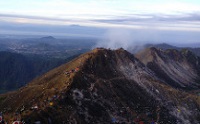
A great place to stop off for travellers en route to the holiday resort of Lake Toba, the town of Berestagi is famed not only for its passion fruit, but also for the two active volcanoes on its doorstep: Gunung Sibayak and Gunung Sinabung. Gunung Sibayak boasts fantastic hot springs whose warm waters are not only open to the public, but are also believed to have therapeutic properties.More active travellers can climb this mountain instead, earning breathtaking views over the island of Sumatra from the top. This is the most commonly climbed volcano in Sumatra as the hike to the top is comparatively easy, with beautiful and unusual scenery to enjoy along the way. It only takes about two hours to summit and can be done safely without a guide. However the addition of a local expert who can explain the geological significance of the area, as well as identify the local flora and fauna, is worth considering. The volcano is still active and as such the boiling sulphur imbues the region with an unmistakable stench, but the breathtaking views will quickly distract you from this unpleasant factor. Why not reward yourself and head to the hot springs after the hike? The pools range in temperature from pleasantly warm to boiling hot, so be sure you test the water and don't burn yourself!

The little village of Bukit Lawang is situated on the eastern banks of the pretty Bahorok River, facing one of the grandest forest areas in South East Asia, the Mount Leuser National Park. With its restful and pleasant setting, this was once one of the most popular tourist destinations in Northern Sumatra, the town existing primarily to cater to the tourist trade, with guides, restaurants and a variety of delightful guesthouses strung along the river. Since November 2003, however, Bukit Lawang has struggled to recover from the massive flash flood that wiped out most of its infrastructure, causing a huge dip in the tourism that once formed the backbone of its economy. Rebuilding is underway and Bukit Lawang has maintained its charm despite disaster. Its major attraction, the Orangutan Rehabilitation Centre across the river, welcomes visitors more enthusiastically than ever.The Rehabilitation Centre helps orphaned orangutans that have been displaced because of land clearing, or rescued from captivity, and teaches them the necessary skills to be able to survive in the wild. Visitors have an opportunity to view the apes twice daily when they come swinging through the trees to collect the bananas and milk left on feeding platforms in the forest, one of the more memorable experiences in Indonesia. Jungle trekking and tubing down the river are other popular activities.
Website : bukitlawang.com
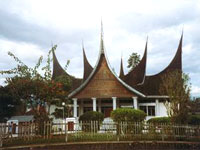
Bukittinggi, or 'high place', is situated on a hill and set among majestic mountains, green plantations and rice terraces. One of the friendliest and most easy-going cities in Sumatra, it is home to the Minangkabau people and the area is steeped in the Minang culture, which is Muslim and strongly matrilineal. Bukittinggi is the commercial, educational and administrative centre of the highlands. One of the features of the town is the characteristic architecture: wooden houses with curved roofs soaring to a point representative of buffalo horns and decorated with beautiful wooden carvings.The Jam Gadang (Great Clock) is a Minangkabau-style clock tower and the town's landmark, overlooking the bustling market place that is crammed with fruit, vegetables and clothing stalls, and rickety horse carts whose drivers insist on squeezing them through the colourful chaos. Pagaruyung Palace is another famous landmark and example of traditional architecture. Nearby Mount Merapi is an active volcano which can be reached on a beautiful hike; this is one of the most popular excursions from Bukittinggi for tourists. There is lots to see and do in the area and Bukittinggi itself is an intriguing city to explore.
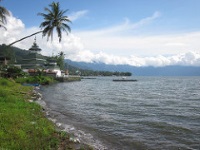
Lake Maninjau is set like a burning sapphire stone in the crater of the mountain and is a spectacularly beautiful place to relax and unwind. It is a caldera lake, located in west Sumatra, and is thought to have been formed by a volcanic eruption around 52,000 years ago. The lake is set at about 1,545 feet (471m) above sea level, and the average temperature of the water in the lake is around 86°F (30°C). Visitors can enjoy cycling the 37 mile (60km) circumference of the lake, or plodding through the neighbouring rice paddies while others can swim, canoe and hike the surrounding mountains or explore the local villages.Villages on the shores of the lake include Maninjau and Bayur. Maninjau is a notable tourist destination in the region due to its scenic beauty and situation on the lake; if you're interested in doing some paragliding Maninjau is a great base. There are some hot springs to enjoy close to the village of Mukomuko, on the opposite side of the lake to Maninjau. On the dramatic road that winds down to the lake from Bukkittinggi there are spectacular views and 44 hairpin turns. Beware of the monkeys that gather on the side of the road; they wait there because people throw food out of the cars for them but they are wild animals and shouldn't be approached.
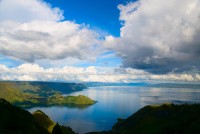
The holiday paradise of Lake Toba, sparkling like a precious stone, is embedded in the northern highlands of Sumatra and is surrounded by steep and fertile mountains. Filling in a giant volcanic crater, it is the largest lake in South East Asia, with depths of up to 1,680 feet (525m) in places. In the middle of Lake Toba sits the jade-green island of Samosir, which is thought to be the origin of the friendly Batak people. Evidence of their culture and traditions is visible in the little Batak villages with their characteristic curved roofs, the traditional dance performances at Simanindo's Batak Cultural Centre, and the distinctive woodcarvings and weavings sold around the island. Apart from this cultural wealth, there are also several hot springs near Pangururan, which attract visitors.Numerous holiday resorts and villages are scattered around Lake Toba's Samosir; the Tuk Tuk peninsula and village of Ambarita being the most popular places for tourists to linger. The area was once very fashionable for holidaymakers, but is now fairly quiet. Despite the amount of guesthouses and restaurants on Samosir, there is little other tourist infrastructure, but the variety of activities and the cultural experience makes this one of Sumatra's most fascinating and relaxing holiday destinations.
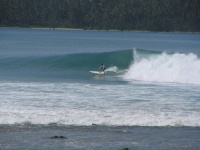
Famed for its right-hand reef breaks, Nias is a key surfing destination for many travelling through the area, with the best known surf spots being Sorake Bay and Lagundri Bay. But this fascinating island also boasts a rich cultural history with prehistoric remains which are thought to have been built in the megalithic Stone Age. Tourists visiting Nias Island can enjoy the war dances performed by locals, among other traditional festivities, and the local music, which is mostly sung by women, is known to be hauntingly beautiful and unique. The beauty of the island is the main draw for those who visit its shores but for the anthropologically-inclined this area is of great interest as its relative geographical isolation has allowed its traditional culture to thrive. Popular activities other than surfing include scuba diving and snorkelling in the clear waters, which brim with rich marine life.More than 1,000 people died in Nias in the 2004 and 2005 earthquakes which shook the region and some evidence of this tragedy may still be visible on the islands, but the tourism industry has recovered. The locals tend to be extremely friendly and they have a respect for the tourism industry as it provides many of their livelihoods.

The capital of Sumatra, Padang offers a compact and enjoyable cross-section of Sumatran life and its various cultures. Many surfers stop here on their way to the Batu or Mentawi Islands, but the town itself boasts a few noteworthy attractions such as the Adityawarman Museum, which features a collection of antiques, and the cultural centre where locals perform traditional dances on Sundays or even pencak silat(martial arts). Many people come here for the markets, for which Padang is famed, but Padang Beach is also popular for its spectacular sunsets and hundreds of colourful food stalls. Another popular beach is Air Manis, which gets mixed reviews from tourists - depending on how clean it is when they visit - but boasts the attraction of a small island which can be waded to at low tide.Lake Maninjau is close enough to make a really pleasant excursion from the city, and Sikuai is less than an hour away by boat. Sikuai Island is renowned for its natural beauty and earns rave reviews from almost all that make the trip. Although not cheap it is still relatively unspoiled and feels like an undiscovered paradise. Padang makes a good base for excursions of this sort and is in close proximity to a number of lovely areas.

Travel Guide powered by Word Travels, copyright © 2023 Globe Media Ltd. By its very nature information in this travel guide is subject to change at short notice and travellers are urged to verify information on which they're relying with the relevant authorities. Neither Globe Media Ltd nor Travel Vogue can accept any responsibility for any loss or inconvenience to any person as a result of information contained above.